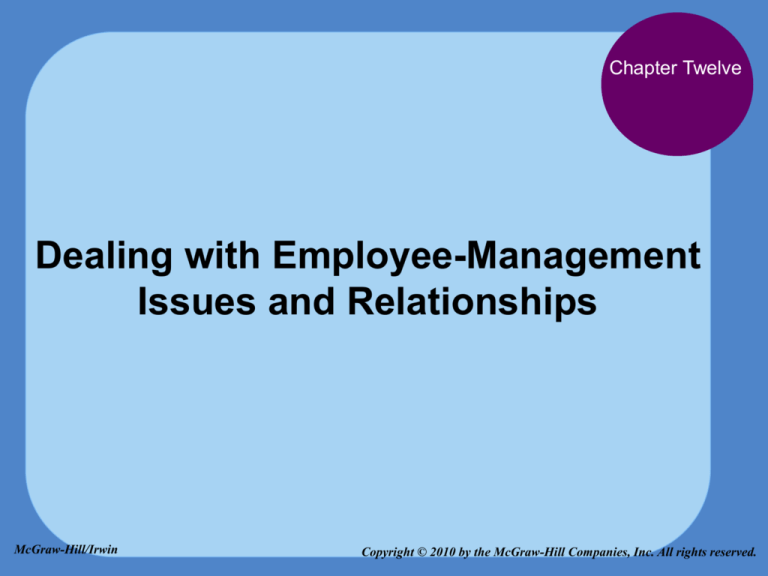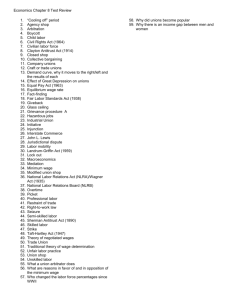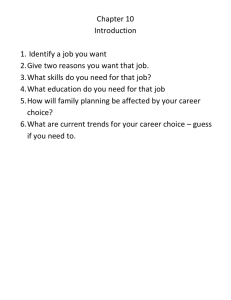
Chapter Twelve
Dealing with Employee-Management
Issues and Relationships
McGraw-Hill/Irwin
Copyright © 2010 by the McGraw-Hill Companies, Inc. All rights reserved.
ORGANIZED LABOR
• Unions -- Employee organizations whose main goal
is to represent members in employee-management
negotiations of job-related issues.
• Labor unions were responsible for:
-
Minimum wage laws
Overtime rules
Workers’ compensation
Severance pay
Child-labor laws
Job-safety regulations
12-2
PUBLIC SECTOR
LABOR UNIONS
• Public sector union members work for
governments as teachers, firefighters, police
officers, etc.
• Many states face serious debt problems and want
to cut labor costs. But states with public sector
unions have limited ability to cut those costs.
12-3
GOALS of ORGANIZED LABOR
• To work with fair and
competent
management.
• To be treated with
human dignity.
• To receive a
reasonable share of
wealth in the work it
generates.
12-4
Labor Union History
12-5
HISTORY of
ORGANIZED LABOR
• Craft Union -- An organization of skilled specialists
in a particular craft or trade.
• As early as 1792, shoemakers in a Philadelphia
craft union met to discuss fundamental work
issues.
• Work weeks were 60+
hours, wages were low and
child labor was rampant.
12-6
EMERGENCE of LABOR
ORGANIZATIONS
• Knights of Labor -- First national labor union;
formed in 1869.
• Knights attracted close to 800,000
members but fell from prominence
after a riot in Chicago.
• American Federation of Labor
(AFL) -- An organization of craft
unions that championed fundamental
labor issues; formed in 1886.
12-7
INDUSTRIAL UNIONS
• Industrial Unions -- Labor unions of
unskilled or semiskilled workers in mass
production industries.
• Congress of Industrial
Organizations (CIO) -- Union
organization of unskilled workers; broke
away from the AFL in 1935 and rejoined
in 1955.
• The AFL-CIO today has affiliations
with 56 unions and about 12.2million
members.
12-8
Labor Legislation
12-9
EFFECTS of LAWS on
LABOR UNIONS
• Labor unions’ growth and influence has been
very dependent on public opinion and law.
12-10
EFFECTS of LAWS on
LABOR UNIONS
Pro-Labor Legislation
12-11
EFFECTS of LAWS on
LABOR UNIONS
Norris-La Guardia Act
Paved way for union growth
• The Norris-LaGuardia Act
helped unions by prohibiting the
use of Yellow-Dog Contracts - A type of contract that
required employees to agree to
NOT join a union.
12-12
EFFECTS of LAWS on
LABOR UNIONS
National Labor Relations Act (NLRA)
Wagner Act
Legal justification for union activities
Collective Bargaining
National Labor Relations Board
Certification and Decertification
12-13
EFFECTS of LAWS on
LABOR UNIONS
• Collective Bargaining -- The process whereby
union and management representatives form an
agreement, or contract, for employees.
12-14
FORMING a UNION
in the WORKPLACE
• The National Labor Relations Board (NLRB)
was created to oversee labor-management
issues and provide guidelines for unionization.
12-15
FORMING a UNION
in the WORKPLACE
• Certification -- The formal process by which a
union is recognized by the NLRB as the bargaining
agent for a group of employees.
• Decertification -- The process whereby employees
take away a union’s right to represent them.
12-16
EFFECTS of LAWS on
LABOR UNIONS
Pro-Management Legislation
12-17
EFFECTS of LAWS on
LABOR UNIONS
Labor-Management Relations Act
Taft-Hartley Act (1947)
12-18
LABOR/MANAGEMENT
AGREEMENTS
• Union Security Clause -- Stipulates workers who
reap union benefits must either join the union or pay
dues to the union.
12-19
UNION SECURITY AGREEMENTS
• Closed Shop Agreement -- Specified workers had
to be members of a union before being hired for a
job.
12-20
UNION SECURITY AGREEMENTS
• Union Shop Agreement -- Declares workers
don’t have to be members of a union to be hired but
must agree to join the union within a specific time
period.
However…
12-21
UNION SECURITY AGREEMENTS
The Taft-Hartley Act also granted states the
power to outlaw union shop agreements.
This led to the creation of the Agency Shop
Agreement
12-22
UNION SECURITY AGREEMENTS
• Agency Shop Agreement -- Allows employers to
hire nonunion workers who don’t have to join the
union, but must pay fees.
12-23
UNION SECURITY AGREEMENTS
Also,
because the Taft-Hartley Act granted states the
power to outlaw union shop agreements, some
states passed…
12-24
RIGHT-to-WORK LAWS
• Right-to-Work Laws -- Legislation that gives
workers the right, under an open shop, to join or not
to join a union,
which created the…
• Open Shop Agreement -- Agreement in right-towork states that gives workers the right to join or not
join a union, if one exists in their workplace.
12-25
STATES with
RIGHT-to-WORK LAWS
12-26
LABOR / MANAGEMENT
AGREEMENTS
12-27
LABOR/MANAGEMENT
AGREEMENTS
Negotiated Labor-Management Agreement
(Labor Contract) -- Sets the terms under which
labor and management will function over a period of
time.
The CBA
12-28
Using Mediation
and Arbitration
12-29
USING MEDIATION and
ARBITRATION
• Bargaining Zone -- The range of options labor and
management have between initial and final contract
offers that each side will consider before an impasse
is reached.
12-30
USING MEDIATION and
ARBITRATION
• Mediation -- The use of a third party to encourage
both sides to keep negotiating to resolve key contract
issues.
• Arbitration -- An agreement to bring in a third party
to render a binding agreement.
12-31
Resolving Contract Disagreements
• Labor contracts outline labor and management’s
rights and serves as a guide to workplace
relations.
• Grievances -- A charge by employees that
management isn’t abiding by the terms of the
negotiated agreement.
• Shop Stewards -- Union officials who work
permanently in an organization and represent
employee interests on a daily basis.
12-32
The GRIEVANCE RESOLUTION
PROCESS
12-33
TACTICS USED in CONFLICTS
• Tactics used by labor unions include:
- Strikes
- Boycotts
- Work Slowdowns
- Pickets
12-34
STRIKES and BOYCOTTS
• Strikes -- A strategy in which
workers refuse to go to work.
• Pickets
• Primary Boycott -- When a union
encourages both its members and
the general public to not buy the
products of a firm in a labor dispute.
• Secondary Boycott -- An
attempt by labor to convince others
to stop doing business with a firm
that’s the subject of a primary
boycott.
12-35
UNION TACTICS USED in CONFLICTS
- Sickouts
12-36
TACTICS USED in CONFLICTS
• Tactics used by management include:
- Lockouts
- Injunctions
- Strikebreakers
12-37
LOCKOUTS, INJUNCTIONS and
STRIKEBREAKERS
• Lockout -- An attempt by management to put
pressure on workers by closing the business thus
cutting off workers’ pay.
• Injunction -- A court order directing someone to do
something or refrain from doing something.
• Strikebreakers -- Workers hired to do the work of
striking workers until the labor dispute is resolved;
called scabs by unions.
12-38
CHALLENGES FACING
LABOR UNIONS
• The percentage of union workers is falling.
• Many workers (like airline employees) have
agreed to Givebacks -- Gains from labor
negotiations are given back to management to help
save jobs.
12-39
LABOR UNIONS in the FUTURE
• Union membership will include more white-collar,
female and foreign-born workers than in the past.
• Unions will take on a greater
role in training workers,
redesigning jobs and
assimilating the changing
workforce.
• Unions will seek more job
security, profit sharing and
increased wages.
12-40
COMPENSATING EXECUTIVES
• CEO compensation used to be determined by a
firm’s profitability or increase in stock price.
• Now, executives receive
stock options and
restricted stock that’s
awarded even if the
company performs poorly.
12-41
COMPENSATING EXECUTIVES
in the FUTURE
• Boards of directors are being challenged
concerning executive contracts.
• Government and shareholders are putting
pressure to overhaul executive compensation.
• Financial crisis of 2008-2009
strengthened the argument
of shareholders concerning
limits on compensation.
12-42
The QUESTION of PAY EQUITY
• Women earn 81% of what
men earn.
• This disparity varies by
profession, experience and
level of education.
12-43
EQUAL PAY for EQUAL WORK
Equal Pay Act Factors that Justify Pay Differences
• Skill
• Effort
• Responsibility
• Working Conditions
12-44
THE SALARY GENDER GAP
Age
Average Salary
15 to 24
Women - $23,357
Men - $26,100
25 to 44
Women - $41,558
Men - $55,286
45 to 64
Women - $44,808
Men - $67,040
Source: U.S. Census Bureau, www.census.gov, accessed June 2011.
12-45
WHAT’S SEXUAL HARASSMENT
• Sexual Harassment -- Unwelcomed sexual
advances, requests for sexual favors or other verbal
or physical conduct that creates a hostile work
environment.
• Sexual harassment laws
cover men, women and
foreign companies doing
business in the U.S.
• Violations can be extremely
expensive for businesses.
12-47
KINDS of SEXUAL HARASSMENT
• Quid pro quo sexual harassment involves threats
like “Go out with me or you’re fired.” An
employee’s job is based on submission.
• Hostile work environment sexual harassment is
conduct that interferes with a worker’s
performance or creates an intimidating or
offensive work environment.
12-48
CHILDCARE ISSUES
• The number of women in the workforce with
children under three-years-old has increased.
• Childcare related absences
cost businesses billions of
dollars each year.
12-49
BUSINESSES RESPONSE to
CHILD CARE
• Benefits can include:
- Discounts with childcare
providers.
- Vouchers that offer payment
for childcare.
- Referral services identify
high-quality childcare
facilities.
- On-site childcare centers
- Sick-child centers.
12-50
FACING CHILDCARE ISSUES
• Who should pay for the cost of
childcare - a dividing issue
among employees and
businesses, and in the
workplace
12-51
INCREASING ELDER CARE
CHALLENGES
• 29% of the adult population
are providing some care to an
elderly person.
• Care giving obligations cause
employees to miss about 15
million days of work per year.
• Costs could rise up to $35
billion annually.
12-52
ELDER CARE in the
MODERN HOUSEHOLD
• More and more boomers are taking care of their
parents while still working.
- 31% say that may delay their retirement.
- The average cost of taking care of an aging parent is
$5,534.
- 76% say they enjoy taking care of their parents.
- 54% say it made them closer.
Source: Money, June 2010.
12-53
DRUG USE in the WORKPLACE
• Alcohol is the most widely used drug - 6.5% of full
time employees are considered heavy drinkers.
• Over 8% of workers aged 18-49 use illegal drugs
and are more likely to be in workplace accidents.
• Drug abuse costs the U.S. economy $414 billion
in lost work, healthcare costs and crime.
• Over 80% of major companies drug test workers.
12-54
VIOLENCE in the WORKPLACE
• OSHA reports homicides account for 16% of
workplace deaths.
• Violence is the number one cause of death for
women in the workplace.
• Companies have taken action to deal with
potential problems by using focus groups and
other interactions.
12-55









